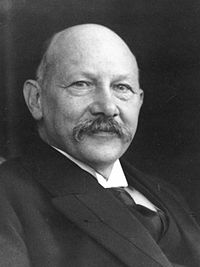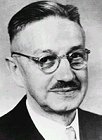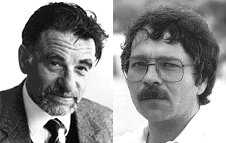Heike Onnes



Courtesy of superconductors.org
Müller and Bednorz

Courtesy of superconductors.org
Then, in 1986, a truly breakthrough discovery was made in the field of superconductivity. Alex Müller and Georg Bednorz, researchers at the IBM Research Laboratory in Rüschlikon, Switzerland, created a brittle ceramic compound that superconducted at the highest temperature then known: 30 K. What made this discovery so remarkable was that ceramics are normally insulators. They don't conduct electricity well at all. So, researchers had not considered them as possible high-temperature superconductor candidates. The Lanthanum, Barium, Copper and Oxygen compound that Müller and Bednorz synthesized, behaved in a not-as-yet-understood way. The discovery of this first of the superconducting copper-oxides (cuprates) won the 2 men a Nobel prize the following year. It was later found that tiny amounts of this material were actually superconducting at 58 K, due to a small amount of lead having been added as a calibration standard - making the discovery even more noteworthy.
Müller and Bednorz' discovery triggered a flurry of activity in the field of superconductivity. Researchers around the world began "cooking" up ceramics of every imaginable combination in a quest for higher and higher Tc's. In January of 1987 a research team at the University of Alabama-Huntsville substituted Yttrium for Lanthanum in the Müller and Bednorz molecule and achieved an incredible 92 K Tc. For the first time a material (today referred to as YBCO) had been found that would superconduct at temperatures warmer than liquid nitrogen - a commonly available coolant. Additional milestones have since been achieved using exotic - and often toxic - elements in the base perovskite ceramic. The current class (or "system") of ceramic superconductors with the highest transition temperatures are the mercuric-cuprates. The first synthesis of one of these compounds was achieved in 1993 at the University of Colorado and by the team of A. Schilling, M. Cantoni, J. D. Guo, and H. R. Ott of Zurich, Switzerland. The world record Tc of 138 K is now held by a thallium-doped, mercuric-cuprate comprised of the elements Mercury, Thallium, Barium, Calcium, Copper and Oxygen. The Tc of this ceramic superconductor was confirmed by Dr. Ron Goldfarb at the National Institute of Standards and Technology-Colorado in February of 1994. Under extreme pressure its Tc can be coaxed up even higher - approximately 25 to 30 degrees more at 300,000 atmospheres.
Bibliography
Main Page
Uses of Superconductors